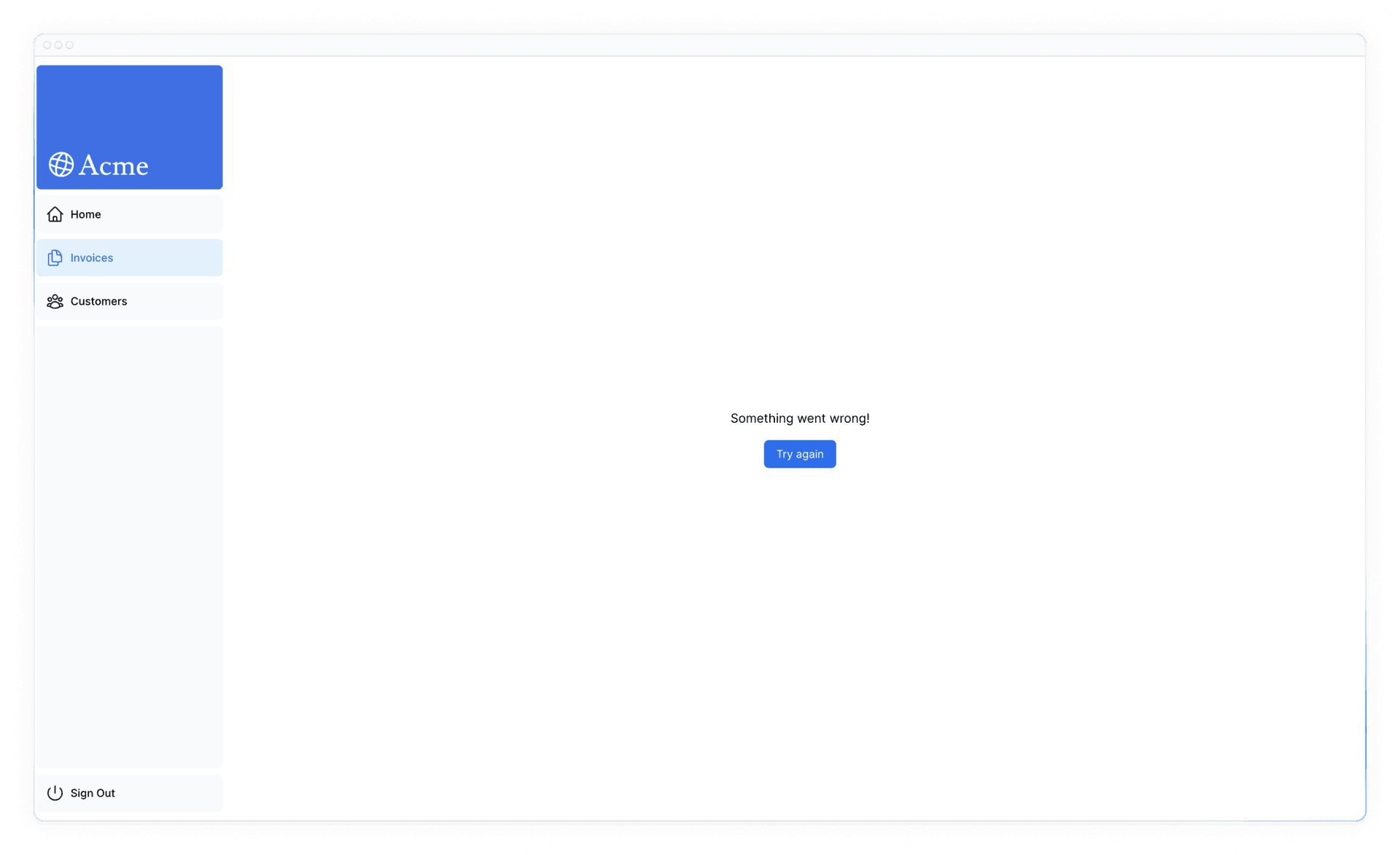13
章节13
错误处理
在上一章中,你学习了如何使用服务器操作来修改数据。现在,让我们看看如何使用 JavaScript 的 try/catch 语句和 Next.js API 来处理未捕获的异常,从而 优雅地 处理错误。
在本章中...
我们将涵盖以下主题:
如何使用特殊的 error.tsx 文件来捕获路由段中的错误,并向用户显示备用 UI。
如何使用 notFound 函数和 not-found 文件来处理 404 错误(针对不存在的资源)。
向服务器操作添加 try/catch
首先,让我们向你的服务器操作添加 JavaScript 的 try/catch 语句,以便优雅地处理错误。
如果你知道如何操作,花几分钟更新你的服务器操作,或者你可以复制下面的代码
注意 redirect 是如何在 try/catch 块之外调用的。这是因为 redirect 通过抛出错误来工作,这将被 catch 块捕获。为了避免这种情况,你可以在 try/catch 之后 调用 redirect。只有当 try 成功时,redirect 才能被执行。
我们通过捕获数据库问题并从服务器操作返回有用的消息来优雅地处理这些错误。
如果你的操作中存在未捕获的异常会发生什么?我们可以通过手动抛出错误来模拟这种情况。例如,在 deleteInvoice 操作中,在函数顶部抛出一个错误
export async function deleteInvoice(id: string) {
throw new Error('Failed to Delete Invoice');
// Unreachable code block
await sql`DELETE FROM invoices WHERE id = ${id}`;
revalidatePath('/dashboard/invoices');
}当你尝试删除发票时,你应该会在本地主机上看到错误。在生产环境中,你希望在发生意外情况时更优雅地向用户显示消息。
这就是 Next.js error.tsx 文件的用武之地。请确保在测试后和进入下一部分之前删除此手动添加的错误。
使用 error.tsx 处理所有错误
error.tsx 文件可用于为路由段定义 UI 边界。它充当所有意外错误的捕获器,并允许你向用户显示备用 UI。
在你的 /dashboard/invoices 文件夹中,创建一个名为 error.tsx 的新文件,并粘贴以下代码
'use client';
import { useEffect } from 'react';
export default function Error({
error,
reset,
}: {
error: Error & { digest?: string };
reset: () => void;
}) {
useEffect(() => {
// Optionally log the error to an error reporting service
console.error(error);
}, [error]);
return (
<main className="flex h-full flex-col items-center justify-center">
<h2 className="text-center">Something went wrong!</h2>
<button
className="mt-4 rounded-md bg-blue-500 px-4 py-2 text-sm text-white transition-colors hover:bg-blue-400"
onClick={
// Attempt to recover by trying to re-render the invoices route
() => reset()
}
>
Try again
</button>
</main>
);
}你会注意到上面代码的一些细节
- “use client” -
error.tsx需要是一个客户端组件。 - 它接受两个 prop
error:此对象是 JavaScript 原生Error对象的实例。reset:这是一个重置错误边界的函数。执行后,该函数将尝试重新渲染路由段。
当你再次尝试删除发票时,你应该会看到以下 UI

使用 notFound 函数处理 404 错误
另一种优雅处理错误的方法是使用 notFound 函数。虽然 error.tsx 对于捕获未捕获的异常很有用,但 notFound 可用于当你尝试获取不存在的资源时。
例如,访问 https://:3000/dashboard/invoices/2e94d1ed-d220-449f-9f11-f0bbceed9645/edit。
这是一个你的数据库中不存在的假 UUID。
你将立即看到 error.tsx 生效,因为这是 /invoices 的子路由,其中定义了 error.tsx。
但是,如果你想更具体,可以显示 404 错误以告知用户他们尝试访问的资源未找到。
你可以通过进入 data.ts 中的 fetchInvoiceById 函数并打印返回的 invoice 来确认资源未找到
export async function fetchInvoiceById(id: string) {
try {
// ...
console.log(invoice); // Invoice is an empty array []
return invoice[0];
} catch (error) {
console.error('Database Error:', error);
throw new Error('Failed to fetch invoice.');
}
}既然你已经知道数据库中不存在该发票,那么让我们使用 notFound 来处理它。导航到 /dashboard/invoices/[id]/edit/page.tsx,并从 'next/navigation' 导入 { notFound }。
然后,你可以使用条件语句在发票不存在时调用 notFound
import { fetchInvoiceById, fetchCustomers } from '@/app/lib/data';
import { notFound } from 'next/navigation';
export default async function Page(props: { params: Promise<{ id: string }> }) {
const params = await props.params;
const id = params.id;
const [invoice, customers] = await Promise.all([
fetchInvoiceById(id),
fetchCustomers(),
]);
if (!invoice) {
notFound();
}
// ...
}然后,为了向用户显示错误 UI,在 /edit 文件夹中创建一个 not-found.tsx 文件。

在 not-found.tsx 文件中,粘贴以下代码
import Link from 'next/link';
import { FaceFrownIcon } from '@heroicons/react/24/outline';
export default function NotFound() {
return (
<main className="flex h-full flex-col items-center justify-center gap-2">
<FaceFrownIcon className="w-10 text-gray-400" />
<h2 className="text-xl font-semibold">404 Not Found</h2>
<p>Could not find the requested invoice.</p>
<Link
href="/dashboard/invoices"
className="mt-4 rounded-md bg-blue-500 px-4 py-2 text-sm text-white transition-colors hover:bg-blue-400"
>
Go Back
</Link>
</main>
);
}刷新路由,现在你应该会看到以下 UI

请记住,notFound 将优先于 error.tsx,因此当你想要处理更具体的错误时,可以利用它!
延伸阅读
要了解更多关于 Next.js 中的错误处理,请查看以下文档
这有帮助吗?


